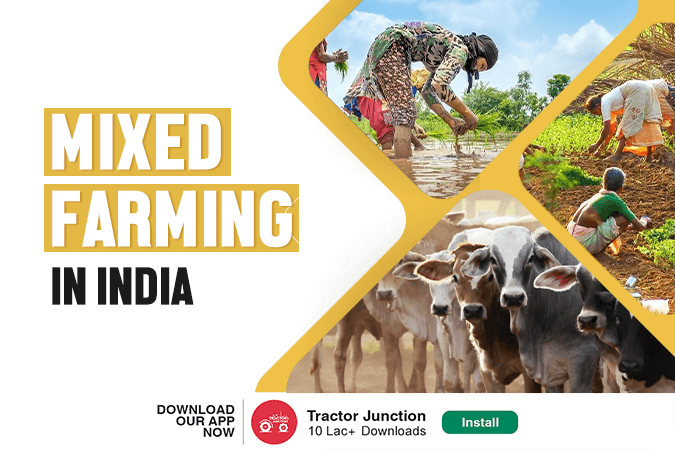
What is Mixed Farming?
Mixed farming is a kind of cultivating that includes both the harvesting of crops and raising animals. It carried across Asia and nations like India, Afghanistan, South Africa, Malaysia, Indonesia, China, Canada, Central Europe, and Russia. It usually serves for domestic utilization in some nations. For example, Japan and the United States currently use it for business purposes. In short, the development of yields and the raising of animals for meat or eggs or milk characterizes mixed cultivation.
Types of Mixed Farming
Following are eight types of mixed farming. Have a look.
1. Subsistence Farming
Subsistence Farming happens when farmers harvest food to meet their families’ issues on smallholdings.It’s Farming targets farm yield for endurance and generally nearby prerequisites, with almost no excess.
2. Shifting Agriculture
Shifting Agriculture is a farming framework wherein plots of land are developed quickly. But, at that point, they deserted while post unsettling influence neglected vegetation is permitted to unreservedly develop while the cultivator continues to another plot.
3. Plantation Agriculture
Plantation Agriculture is a business in which a solitary yield is developed all year long. This kind of cultivation requires an enormous measure of labour and capital. The yield creation might be additionally handled on the farm where it is developed or in neighbouring production lines or limited scope enterprises.
4. Intensive Farming
Intensive farming, otherwise called Intensive cultivation (rather than broad cultivating), traditional or modern farming, is a sort of agribusiness, both of yield plants and animals, with more elevated levels of info and result per unit of agriculture land region.
5. Dry Agriculture
Dry Agriculture and dryland cultivation incorporate explicit rural methods for the non-watered development of harvests. Dryland cultivating is related to drylands, regions described by a cool, wet season trailed by a warm, dry season. They are additionally connected with bone-dry conditions, areas inclined to dry spells and those having scant water assets.
6. Mixed and Multiple Agriculture
In horticulture, mixed agriculture or multi cropping is the act of growing at least two yields in a similar real estate during one developing season rather than only one harvest. At the point when various yields are developed simultaneously, this is otherwise called intercropping. This editing framework assists farmers with multiplying their harvest efficiency and pay.
7. Crop Rotation
Crop Rotation is the act of establishing various harvests consecutively on a similar plot of land to further develop soil wellbeing, streamline supplements in the soil, and weed pressure. A short turn may include a few harvests, and complex rotation may join at least twelve.
8. Terrace Cultivation
Terrace Cultivation comprises various “steps” that created in different spots all over the world. This technique for cultivating farmers “steps” incorporated into the side of a mountain or slope. On each level, different yields planted. At the point when it downpours, rather than washing ceaselessly every one of the supplements in the soil, the supplements conveyed down to a higher level.
Characteristics of Mixed Farming
- Crops are develop, and animals raised on similar land.
- A piece of land held for the animal field. To raise animals or develop animal feed on the off chance that a farmer chooses to raise his animals in uncommon planned structures.
- Farms are average in size.
- Extra crop utilized for grain. After collecting, the farmer uses the extra yield, saving some pay for purchasing animal food and providing them with quality yearly items like meat and milk.
- Fertilizer from creatures is utiliz to prepare the soil for crops. Animal raising provides the farmers with fertiliser that they can apply on the land to build soil fruitfulness, thus offering the farmer to expand their production and increment his pay.
Benefits of Mixed Farming
Following are some advantages of mixed farming. Check out below.
- At the time yield comes up short or costs change, the farmers can rely upon animals.
- The farmers get pay persistently. If animal raising directed over time, the farmer’s pay stays stable.
- Pay increases. Mixed pay from selling crop gather and animal items are bigger when contrasted with crop cultivating alone or creature raising alone.
- The farmer occupied it consistently. After the gathering, the farmer focuses on raising animals that guarantee solid pay.
- Utilizing extra crop as grain sets aside cash for purchasing it.
- Utilizing compost from creatures guarantees supported harvest creation and sets aside cash that would used to purchase fertilizer.
Mixed Farming Advantages and Disadvantages
Following are the major advantages and disadvantages of mixed farming:-

Where Mixed Farming Practiced in India?
Mixed crop and livestock farming mainly practiced in Odisha and Kerala in India. A mixed crop farming framework is helpful in diminishing the expense of creation per unit region, expanding pay and usefulness, and reducing farmers’ risk.
These are all about mixed farming and mixed cropping in India. I hope you get all the information about mixed farming advantages and disadvantages. For more information regarding commercial mixed farming, stay connected with Tractor Junction.
Related Post
What is Animal Husbandry
Types of Farming in India


